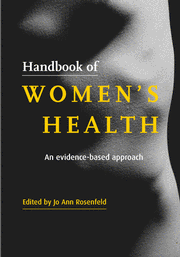Book contents
- Frontmatter
- Contents
- List of contributors
- Common abbreviations used in the text
- Normal blood values in women and during pregnancy
- Introduction
- 1 Singular health care of women
- Preventive care
- Psychosocial health
- Sexuality
- Genitourinary medicine
- Breast disorders
- Psychological disorders
- Common medical problems
- 29 Coronary heart disease
- 30 Diabetes mellitus type II
- 31 Thyroid disorders
- 32 Hypertension and stroke
- 33 Osteoporosis, osteoarthritis, and rheumatoid arthritis
- Index
33 - Osteoporosis, osteoarthritis, and rheumatoid arthritis
Published online by Cambridge University Press: 28 October 2009
- Frontmatter
- Contents
- List of contributors
- Common abbreviations used in the text
- Normal blood values in women and during pregnancy
- Introduction
- 1 Singular health care of women
- Preventive care
- Psychosocial health
- Sexuality
- Genitourinary medicine
- Breast disorders
- Psychological disorders
- Common medical problems
- 29 Coronary heart disease
- 30 Diabetes mellitus type II
- 31 Thyroid disorders
- 32 Hypertension and stroke
- 33 Osteoporosis, osteoarthritis, and rheumatoid arthritis
- Index
Summary
Osteoporosis, osteoarthritis, and rheumatoid arthritis are chronic common diseases that affect women predominantly and cause a significant disability.
Osteoporosis
Osteoporosis (OP) is a condition in which an individual develops a low bone mass or density (BMD), resulting in an increased risk of fractures. This occurs in women and men, but there is an increased rate of bone loss in post-menopausal women.
OP leads to an increased risk of fractures, resulting in health complications such as pneumonia and lung disease and chronic obstructive pulmonary disease, chronic pain, disability, and loss of independence.
Epidemiology
OP is common and its incidence increases with age. The prevalence of OP in women aged 50 to 54 years in the UK is between 2.0 and 3.5 percent. The prevalence rises to 14 to 20 percent in women aged 70 to 74 years.
There is an increasing risk of fracture with decreasing bone density. Ade-crease of one standard deviation in bone density increases the risk of fractures 1.5 to 3 times.
One in six white women will have an OP-related hip fracture in her lifetime. Fifty-four percent of 50-year-old women will have an OP related fracture during their lifetimes. The lifetime risk of a hip fracture for a 50-year-old British woman is 14 percent, a vertebral fracture 11 percent and radial fracture 13 percent. This risk is as great as that of heart disease and six times higher than breast cancer.
[…]
- Type
- Chapter
- Information
- Handbook of Women's HealthAn Evidence-Based Approach, pp. 569 - 594Publisher: Cambridge University PressPrint publication year: 2001



